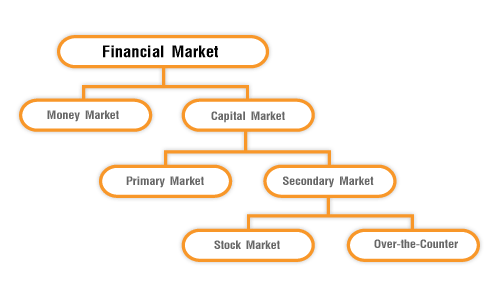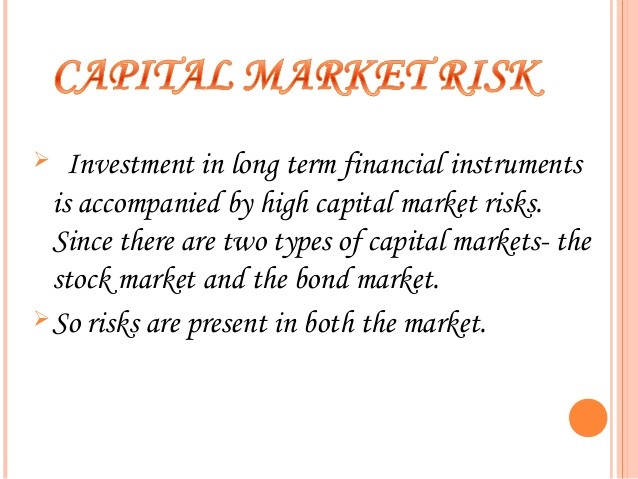Capital markets and capital market instruments
Post on: 16 Май, 2015 No Comment

Capital market
The capital market (securities markets) is the market for securities, where companies and the government can raise long-term funds. The capital market includes the stock market and the bond market. Financial regulators, oversee the capital markets in their respective countries to ensure that investors are protected against fraud. The capital markets consist of the primary market, where new issues are distributed to investors, and the secondary market, where existing securities are traded.
Stock market
The term ‘the stock market’ is a concept for the mechanism that enables the trading of company stocks (collective shares), other securities, and derivatives. Bonds are still traditionally traded in an informal, over-the-counter market known as the bond market. Commodities are traded in commodities markets, and derivatives are traded in a variety of markets (but, like bonds, mostly ‘over-the-counter’).
The size of the worldwide ‘bond market’ is estimated at $45 trillion. The size of the ‘stock market’ is estimated at about $51 trillion. The world derivatives market has been estimated at about $300 trillion. It must be noted though that the derivatives market, because it is stated in terms of notional outstanding amounts, cannot be directly compared to a stock or fixed income market, which refers to actual value.
The stocks are listed and traded on stock exchanges which are entities (a corporation or mutual organisation) specialised in the business of bringing buyers and sellers of stocks and securities together.
Primary markets
The primary market is that part of the capital markets that deals with the issuance of new securities. Companies, governments or public sector institutions can obtain funding through the sale of a new stock or bond issue. This is typically done through a syndicate of securities dealers. The process of selling new issues to investors is called underwriting. In the case of a new stock issue, this sale is an initial public offering (IPO). Dealers earn a commission that is built into the price of the security offering, though it can be found in the prospectus.
Features of a primary market are:
- This is the market for new long term capital. The primary market is the market where the securities are sold for the first time. Therefore it is also called New Issue Market (NIM)
- In a primary issue, the securities are issued by the company directly to investors
- The company receives the money and issue new security certificates to the investors
- Primary issues are used by companies for the purpose of setting up new business or for expanding or modernizing the existing business
- The primary market performs the crucial function of facilitating capital formation in the economy
- The new issue market does not include certain other sources of new long term external finance, such as loans from financial institutions. Borrowers in the new issue market may be raising capital for converting private capital into public capital; this is known as ‘going public’

Secondary markets
The secondary market is the financial market for trading of securities that have already been issued in an initial private or public offering. Alternatively, secondary market can refer to the market for any kind of used goods. The market that exists in a new security just after the new issue, is often referred to as the aftermarket. Once a newly issued stock is listed on a stock exchange, investors and speculators can easily trade on the exchange, as market makers provide bids and offers in the new stock.
In the secondary market, securities are sold by and transferred from one investor or speculator to another. It is therefore important that the secondary market be highly liquid and transparent. Before electronic means of communications, the only way to create this liquidity was for investors and speculators to meet at a fixed place regularly. This is how stock exchanges originated.
The rationale for secondary markets
Secondary marketing is vital to an efficient and modern capital market. Fundamentally, secondary markets mesh the investor’s preference for liquidity (i.e. the investor’s desire not to tie up his or her money for a long period of time, in case the investor needs it to deal with unforeseen circumstances) with the capital user’s preference to be able to use the capital for an extended period of time.
For example, a traditional loan allows the borrower to pay back the loan, with interest, over a certain period. For the length of that period of time, the bulk of the lender’s investment is inaccessible to the lender, even in cases of emergencies. Likewise, in an emergency, a partner in a traditional partnership is only able to access his or her original investment if he or she finds another investor willing to buy out his or her interest in the partnership. With a securitised loan or equity interest (such as bonds) or tradable stocks, the investor can sell, relatively easily, his or her interest in the investment, particularly if the loan or ownership equity has been broken into relatively small parts. This selling and buying of small parts of a larger loan or ownership interest in a venture is called secondary market trading.
Under traditional lending and partnership arrangements, investors may be less likely to put their money into long-term investments, and more likely to charge a higher interest rate (or demand a greater share of the profits) if they do. With secondary markets, however, investors know that they can recoup some of their investment quickly, if their own circumstances change.
The Johannesburg Stock Exchange (JSE)
The JSE provides a market where securities can by traded freely under a regulated procedure. It not only channels funds into the economy, but also provides investors with returns on investments in the form of dividends.
The exchange successfully fulfils its main function — the raising of primary capital — by re-channelling cash resources into productive economic activity, thus building the economy while enhancing job opportunities and wealth creation.
The exchange is directed by an honorary committee of 16 people, all with full voting rights. The elected stock broking members, who may not number less than eight nor more than eleven, may appoint an executive president and five outside members to the committee. Policy decisions are made by the committee and carried out by a full-time executive committee headed by the executive president.
The JSE is governed by its members but through their use of JSE services and facilities, these members are also customers of the Exchange. Although there is only one stock exchange in South Africa, the Stock Exchanges Control Act does allow for the existence and operation of more than one exchange. Each year the JSE must apply to the Minister of Finance for an operating licence which vests external control of the exchange in the Financial Services Board (FSB).
The JSE makes use of fully automatic electronic trading on the JET System (Johannesburg Equities Trading). The system is an order-driven automated trading system acquired from the Chicago Stock Exchange, which has successfully installed the system at several other exchanges around the world.














